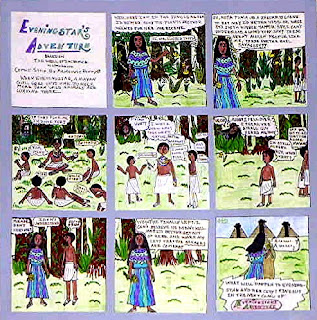Too many students think history is dry and boring. Historical fiction
can bring history to life with action, adventure, and relatable characters.
What is historical fiction?
A real setting, with characters either real
or imagined. The plot may be based on real events and partially fictionalized
or dramatized, or it may be entirely fictional.
What can historical fiction do?
Bring history to life. Create a vivid
background and greater drama. Author Jane Yolen says, “[F]or young students,
history comes alive when we concentrate on the end of the word — hiSTORY.
Historical fiction can also connect history to
other fields – science (inventions, discoveries, medicine, archeology,
anthropology); geography (landscape, climate, flora and fauna); environmental
issues; politics; culture (foods, clothing, religious beliefs and values);
language (vocabulary, foreign language); art, music and drama.
What makes good historical fiction?
- The story comes first. It's about interesting people doing challenging things in an exciting time and place.
- Details should be relevant and fit naturally into the story. The action shouldn't stop for facts.
- Historical fiction should not be an excuse to lecture within a fictional framework.
- The characters should feel real. Although specifics of religion, social structure and politics differ by time and place, people are motivated by the same basic emotions: love, fear, greed, insecurity, pride, piety, etc. After all, the seven deadly sins are thousands of years old.
Making history live
The best lessons appeal to all five senses. People
learn in different ways –through reading, through hearing material allowed, and
through doing activities. To get children involved in history and historical
fiction, bring the lessons beyond the book(s). Field trips to actual historical
sites or museums are great, but there are other options.
Find a parent who has traveled to, or is
from, another country and ask them to give a talk. Or ask an expert to visit. Authors
may be able to do a classroom visit, in person or via Skype. Actors can help as
well – imagine someone talking about ancient Egypt while dressed as a Pharaoh!
Bring in photos or drawings, clothing, toys,
and other objects. (Museums and libraries sometimes have educational packs that
can be lent out.)
Have the children make posters, act out
skits, and write their own stories. For my Mayan novel, The Well of Sacrifice, teachers have developed many classroom
projects. (Find these in my Lesson
Plans.)
- A group debate project where the students take on the roles of various characters from the book.
- Discussion questions about social roles, coming-of-age rituals, attitude towards death, and more.
- Various art projects, including comic strips, designing a monument, and drawing scenes from the book.
- Team research projects where the students find out more about the Maya.
- A persuasive letter project where the student writes as a character and tries to convince another character to do something.
- Journal questions covering topics such as “Is human sacrifice different from murder? Why or why not?”
At the end of an educational
segment centered around The Well of
Sacrifice, the teacher may have a party for the kids. Some parents make
food appropriate for the historical time and place. The kids share their
posters and present their research. They dress in costumes and act out scenes
from the book. It's a great time for everyone.
Mayan Pectoral Project
The Maya wore simple
clothing—loincloths and cloaks for men, and a sleeveless dress for women.
Peasants may have used bark cloth, while the nobility had clothes woven from
colorful dyed cotton. Both men and women wore their hair long, often braided in
two or four plaits. They also wore necklaces, bracelets, and jewelry in their
ears, noses and lips. The jewelry was made of bone, shell, wood or stone for
poor people, and of gold or jade for the rich.
Sometimes people wore
pectorals—large pendants hanging over the chest. Some were simple circles or
rectangles, but others were complex. Here are some designs, taken from ancient
paintings and statues. The real ones would have been even bigger—up to six
inches across.
You can make your own
pectoral. Use the designs here to get ideas. Cut shapes out of colored
construction paper and glue or tape them together. You can also paint or draw
the designs. Have fun!
— Chris Eboch, The Well of Sacrifice
Chris Eboch’s novels for ages nine and up include The Eyes of Pharaoh, a mystery in
ancient Egypt; The Well of Sacrifice,
a Mayan adventure; The Genie’s Gift,
a middle eastern fantasy; and the Haunted series, about kids who travel with a
ghost hunter TV show, which starts with The
Ghost on the Stairs. Her writing craft books include You Can Write for Children: How to Write Great Stories, Articles, and
Books for Kids and Teenagers, and Advanced
Plotting.
Learn more at www.chriseboch.com
or her
Amazon page, or check out her writing tips at her Write Like a Pro! blog.
Subscribe to get posts automatically and never miss a post.
You can use the Subscribe buttons to the right, or add
http://madaboutmghistory.blogspot.com/ to Feedly or another reader.















